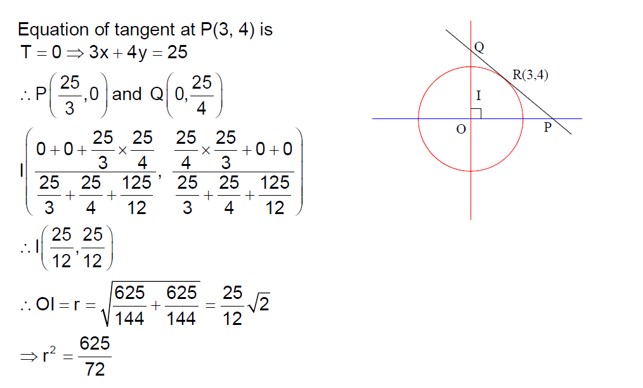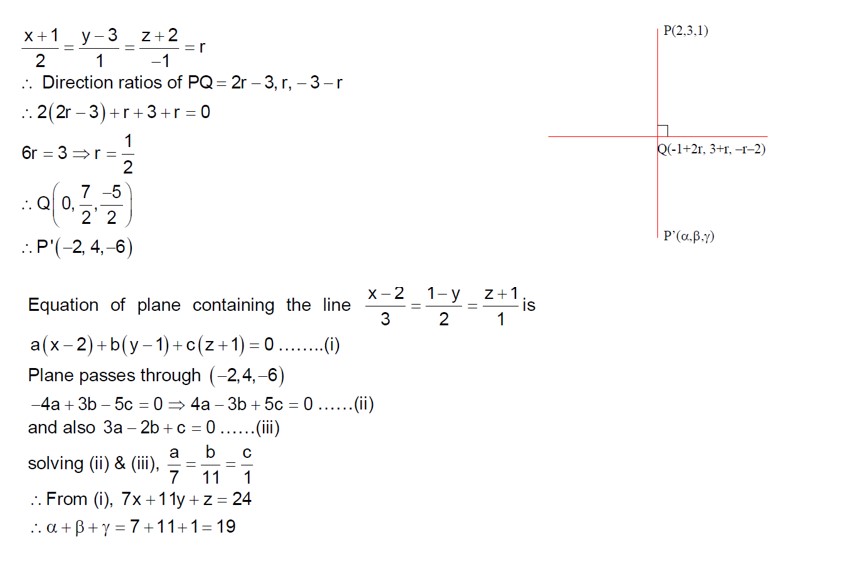Maths
Get insights from 6.5k questions on Maths, answered by students, alumni, and experts. You may also ask and answer any question you like about Maths
Follow Ask QuestionQuestions
Discussions
Active Users
Followers
New answer posted
2 months agoContributor-Level 10
Given matrices A = [[a, b], [c, d]] and B = [[α], [β]] where B ≠ [[0], [0]].
The product AB is:
AB = [[a, b], [c, d]] * [[α], [β]] = [[aα + bβ], [cα + dβ]]
From the problem statement AB = B, we have:
aα + bβ = α (i)
cα + dβ = β (ii)
Rearranging these equations:
(a - 1)α + bβ = 0
cα + (d - 1)β = 0
For this system of linear equations to have a non-trivial solution (since B is not the zero matrix), the determinant of the coefficient matrix must be zero.
det([[a-1, b], [c, d-1]]) = 0
(a - 1)(d - 1) - bc = 0
ad - a - d + 1 - bc = 0
ad - bc = a + d - 1
The provided text jumps to the conclusion ad - bc = 2020.
New answer posted
2 months agoContributor-Level 10
Given the integral In = ∫(log|x|)^n / x^19 dx.
Let t = log|x|, which implies x = e^t and dx = e^t dt.
The integral becomes:
In = ∫ e^(-20t) * t^n dt
Using integration by parts, where u = t^n and dv = e^(-20t) dt:
In = [t^n * e^(-20t) / -20] - ∫ n*t^(n-1) * e^(-20t) / -20 dt
In = e^(-20) / -20 - (n / -20) * In-1
20 * In = -e^(-20) + n * In-1
For n = 10: 20 * I10 = e^20 - 10 * I9 (Note: There seems to be a sign inconsistency in the original document's derivation vs. standard integration by parts, the document states e^20 instead of -e^(-20) and proceeds with e^20).
For n = 9: 20 * I9 = e^20 - 9 * I8
From these two equations, we can express e
New answer posted
2 months agoContributor-Level 10
To find the sum Σ[r=0 to 6] (?C?)².
This is the coefficient of x? in the expansion of (1+x)?(x+1)? = (1+x)¹².
By the binomial theorem, (1+x)¹² = Σ[k=0 to 12] ¹²C? x?.
The coefficient of x? is ¹²C?.
¹²C? = (12 * 11 * 10 * 9 * 8 * 7) / (6 * 5 * 4 * 3 * 2 * 1) = 11 * 2 * 3 * 2 * 7 = 924.
New answer posted
2 months agoContributor-Level 10
I = ∫[0 to 10] [sin(2πx)] / e^(x-[x]) dx.
The period of the integrand involves [sin(2πx)] which depends on the sign of sin(2πx) and {x} = x - [x], which has a period of 1.
Let f(x) = [sin(2πx)] / e^{x}.
The integral is ∫[0 to 10] f(x) dx = 10 * ∫[0 to 1] f(x) dx due to the periodicity of {x} and the integer period of sin(2πx).
In the interval (0, 1/2), sin(2πx) is between 0 and 1, so [sin(2πx)] = 0.
In the interval (1/2, 1), sin(2πx) is between -1 and 0, so [sin(2πx)] = -1.
At x=0, 1/2, 1, the value is 0.
So, ∫[0 to 1] f(x) dx = ∫[0 to 1/2] 0 dx + ∫[1/2 to 1] -1/e^x dx
= 0 + [-e^(-x) * (-1)] from 1/2 to 1 = [e^(-x)] from 1
New answer posted
2 months agoContributor-Level 10
Find the number of solutions for 2tan(x) = π/2 - x in [0, 2π].
This is equivalent to finding the number of intersection points of the graphs y = tan(x) and y = (π/4) - x/2.
Let's sketch the graphs:
y = tan(x) has vertical asymptotes at x = π/2, 3π/2.
y = (π/4) - x/2 is a straight line with a negative slope.
At x=0, y=π/4.
At x=π/2, y=0.
At x=π, y=-π/4.
At x=2π, y=-3π/4.
By observing the graphs, there will be one intersection in (0, π/2), one in (π/2, 3π/2), and one in (3π/2, 2π].
Total number of solutions is 3.
New answer posted
2 months agoContributor-Level 10
Parabola: y² = 4x - 20 = 4(x - 5). Vertex at (5,0).
Line: The text seems to derive the tangent equation y = x - 4. This is not a tangent to the given parabola. The standard tangent to y²=4aX is Y=mX+a/m. Here X=x-5, a=1. So y = m(x-5)+1/m.
The other curve is an ellipse: x²/a² + y²/b² = 1.
The text says x²/2 + (x-4)²/b² = 1. This assumes a² = 2.
x²/2 + (x²-8x+16)/b² = 1
x²(1/2 + 1/b²) - (8/b²)x + (16/b² - 1) = 0.
For tangency, the discriminant (D) of this quadratic equation must be zero.
D = (8/b²)² - 4(1/2 + 1/b²)(16/b² - 1) = 0.
64/b? - 4(8/b² - 1/2 + 16/b? - 1/b²) = 0.
16/b? - (7/b² - 1/2 + 16/b?) = 0.
-7/b² + 1/2 = 0
New answer posted
2 months agoContributor-Level 10
Given that x, y, z are in A.P., so 2y = x + z.
The determinant is:
| 3 4√2 x |
| 4 5√2 y | = 0
| 5 k z |
Apply the operation R? → R? + R? - 2R?:
The first row becomes:
(3 + 5 - 24) (4√2 + k - 25√2) (x + z - 2y)
= 0 (k - 6√2) (0)
So the determinant becomes:
| 0 k-6√2 0 |
| 4 5√2 y | = 0
| 5 k z |
Expanding along the first row:
-(k - 6√2)(4z - 5y) = 0.
This implies k - 6√2 = 0 or 4z - 5y = 0.
k = 6√2 or y = 4z/5.
The condition y = 4z/5 is stated as not possible.
Therefore, k = 6√2, which means k² = (6√2)² = 36 * 2 = 72.
Taking an Exam? Selecting a College?
Get authentic answers from experts, students and alumni that you won't find anywhere else
Sign Up on ShikshaOn Shiksha, get access to
- 65k Colleges
- 1.2k Exams
- 679k Reviews
- 1800k Answers



